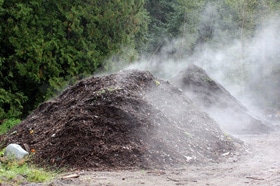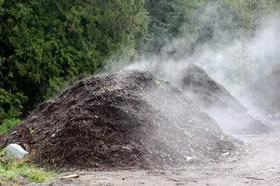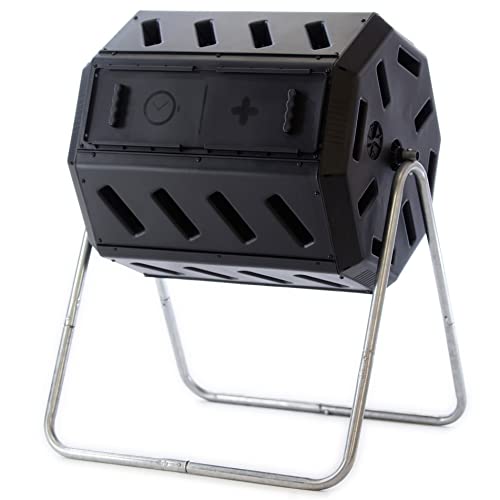
Benefits of Composting
Benefits of Composting – Its Good for the Environment
![]() Composting of waste (mostly garden waste and food waste) has grown rapidly in the last ten years, with the benefits of composting been seen by more than just gardeners. Nowadays the vast majority of households are collecting household rubbish, garden and other green waste separately for composting either in their own back yard or in municipal facilities.
Composting of waste (mostly garden waste and food waste) has grown rapidly in the last ten years, with the benefits of composting been seen by more than just gardeners. Nowadays the vast majority of households are collecting household rubbish, garden and other green waste separately for composting either in their own back yard or in municipal facilities.
Composting is a form of organic recycling and is nothing more than a collection of different organic matter, such as grass and hedge clippings, small twigs, leaves and organic kitchen waste that have gone through the process of decomposition in exactly the same way as mother nature has been doing for millions of years.
More and more people are going back to basics and realise the benefits of composting by growing their own vegetables at home. They realise that not only are they cheaper and fresher for them but its better for the environment as it enables them to get rid of their left over food and animal waste.

The whole concept of composting at home may seem daunting but it is very easy to do and once you get started then nature literally takes over, the hardest part is setting your compost pile up but once done you will soon see the benefits of composting at home.
Composting is in fact the ultimate in recycling as it provides you with healthy soil which will help you grow bigger and better crops to feed you and your family so composting is a good way to divert solid waste from landfills saving the environment.
What are the Benefits of Composting
Regardless of scale or size, the benefits of composting are huge as once your compost is established it takes very little work and time to maintain. The basic principles of creating compost are generally the same, but its a slow process as the microorganisms need time to break down the organic materials into quality compost.
Composting can take place in many different forms such as backyard, community, on-farm, municipal and regional composting centres at a range of locations. Home composting can take up to 12 months for your scraps to turn into usable soil, so you will have to be patient.
The composting process involves four different components that are required to create a mixture that will deliver the sought after benefits of compost. The four main components are organic matter, correct moisture, sufficient oxygen and bacteria.
The key to a successful compost is the bacteria as it is the bacteria, and other types of micro-organisms, that do the real work involved in the composting process. With the other needed elements in place, the bacteria can go to work breaking down the organic components into usable compost for any the organic garden.
Benefits of Composting Include
- Reduces greenhouse gas methane emissions from landfills preventing it from heating up the atmosphere.
- Reduces the quantity of waste going to landfill.
- Recycles organic materials into a valuable and sustainable soil compost.
- Enriches the soil and makes it healthier by reintroducing nutrients, microbes, and other beneficial composting organisms.
- Keeps you aware of the amount of waste and the types of food you are wasting.
Then you can see that the benefits of composting can be huge and limitless but when it comes to compost, there are two main types: Aerobic Compost and Anaerobic Compost.
The Benefits of Aerobic Compositing
aerobic composting requires air, specifically oxygen, to complete the decomposition process. Air breathing aerobic bacteria are very efficient and once they get started break down the organic and waste matter very quickly. Turning over the compost with a pitchfork or shovel at least once or twice a week aerates the pile turning the fresher outside materials into the centre of the newly turned pile and vice-versa.
Given the right conditions its possible for them to complete the full composting process in less than 6-8 weeks. Furthermore, aerobic microbes don’t give off smelly gasses, which means that aerobic composting is a virtually odourless process.
Also the action of turning over the compost regularly to accelerate its decomposition process is called active composting. Just turning the pile will allow excess water to evaporate and will bring fresh air into the pile.
Of course for an aerobic compost heap there are a few rules to create an efficient compost heap or bin. To get the full benefits of composting materials it is better to alternate layers of different materials, called greens and browns to allow the different microbes and bugs a balanced diet. A mix of greens and browns is equally important in producing quick results so fill your compost heap, or composting bin with 1 part “Green” materials to about 30 parts of “Brown” materials.
If you layer a load of fresh grass cuttings on, the greens, it’s best to then follow that with some dry leaves, newspaper or cardboard, the browns. This way the compost heap doesn’t end up either too wet or too dry. If kept correctly, and looked after well you will have a fantastic home compost pile but an aerobic composting heap with too many browns would take a long time to decompose, while too many greens would end up with a smelly algae type mess.
The Benefits of Anaerobic Compositing
Anaerobic composting basically consists of piling up a bunch of organic materials, covering it over with plastic, canvas or tarpaulin then leaving it to sit and rot. Anaerobic bacteria are slow and inefficient, which means that your compost pile will have to sit there for at least a year, maybe longer, before the materials at the very bottom are fully composted. Second of all, microbes that do the decaying in anaerobic composting produce methane and smelly gasses as a by-product.
Anaerobic Composting works best with nitrogen-rich materials as they are mainly wet. Ideally the compost should be slightly moist, like a damp sponge, in order to ensure bacterial decomposition.
An alternative approach is to bury it underground. This type of passive anaerobic composting, called pit composting, seals the solid feedstock waste from exposure to the air and oxygen by burying underground. This is the simplest way to compost, if you do not mind digging.
Wet Anaerobic Digester’s on the other hand use animal and poultry manures, slurries, effluent’s and green organic materials mixed with water. The water content of the liquid feedstock is very high at more than 80% of the volume. Wet Anaerobic Composting converts liquid organic waste into a rich source of renewable energy in the form of “Biogas” containing methane.
Composting Benefits the Environment
Composting benefits the environment, the local economy, and our plants and gardens in so many ways. Composting is one of the fundamental ways we can address climate change and is easier than you might think. It is also an excellent way to curb your overspending habits at the grocery store.
When it comes to improving the soil structure of your yard or gardens, there is no better way than amending your existing soil with organic matter. The benefits of composting not only provide you with a source of nutrients but it is also an excellent soil additive and conditioner as composting turns your waste into soil increasing the productivity and workability of any poor quality garden soil.
Also, by making the soil richer it helps plants grow which in turn helps the Earth in so many different ways from irrigation to food production. This is why aerobic compost is prized by gardeners and garden centres alike often referring to it as black gold.
With a little time and effort, you’ll have finished compost readily available from your compost heap or bin. This finished compost can be tilled into your garden soil or added to the topsoil around existing plants as a fertilizer. You’ll soon begin to see the results that compost has on a garden with bigger plants, more flowers, and larger harvests of vegetables. So what are you waiting for, start composting today as the benefits of composting will soon be seen in the garden.
To learn more about how “Aerobic Composting” works, to obtain more information about the various composting methods and materials available, or to explore the advantages and disadvantages of composting, then Click Here today to get your copy of one of the top “Composting Guides” today from Amazon and learn more about the different ways to produce good quality compost in your garden to save money and the environment.











I would love to grow mushrooms but what type of compost is best, also is there any other way to grow them? Such as planting mushrooms directly into the compost. Apologies if it’s a dumb question I’m a first timer at this!!
Hi!
I’m not exactly a newbie to composting but I haven’t done it in many years (been living in a city where bins are frowned upon) and have a question.
I noticed that it’s okay to put cardboard egg cartons & paper towel tubes in the pile, but what about paper plates? I mean the plain white ones, not the ones with color on them. I use the plain ones when we go on picnics and we mostly eat sandwiches. Would these be okay to put on the pile if I shred them up a bit first?
Thanks for your advice!